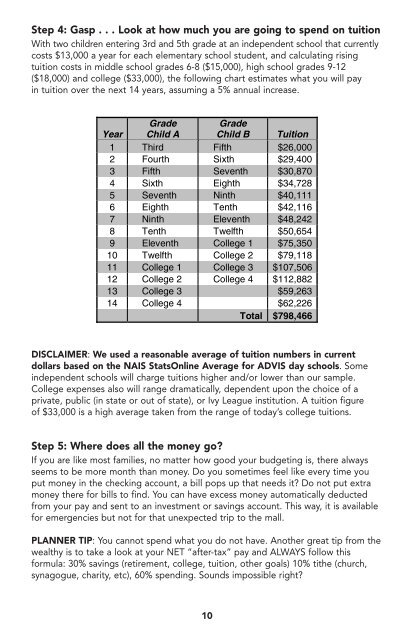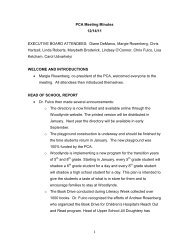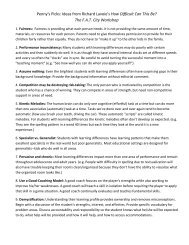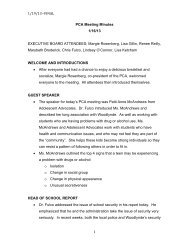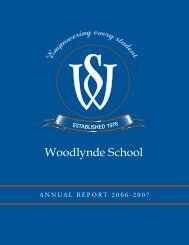ADVIS Financial Strategies - Woodlynde School
ADVIS Financial Strategies - Woodlynde School
ADVIS Financial Strategies - Woodlynde School
Create successful ePaper yourself
Turn your PDF publications into a flip-book with our unique Google optimized e-Paper software.
Step 4: Gasp . . . Look at how much you are going to spend on tuition<br />
With two children entering 3rd and 5th grade at an independent school that currently<br />
costs $13,000 a year for each elementary school student, and calculating rising<br />
tuition costs in middle school grades 6-8 ($15,000), high school grades 9-12<br />
($18,000) and college ($33,000), the following chart estimates what you will pay<br />
in tuition over the next 14 years, assuming a 5% annual increase.<br />
Year<br />
Grade<br />
Child A<br />
Grade<br />
Child B Tuition<br />
1 Third Fifth $26,000<br />
2 Fourth Sixth $29,400<br />
3 Fifth Seventh $30,870<br />
4 Sixth Eighth $34,728<br />
5 Seventh Ninth $40,111<br />
6 Eighth Tenth $42,116<br />
7 Ninth Eleventh $48,242<br />
8 Tenth Twelfth $50,654<br />
9 Eleventh College 1 $75,350<br />
10 Twelfth College 2 $79,118<br />
11 College 1 College 3 $107,506<br />
12 College 2 College 4 $112,882<br />
13 College 3 $59,263<br />
14 College 4 $62,226<br />
Total $798,466<br />
DISCLAIMER: We used a reasonable average of tuition numbers in current<br />
dollars based on the NAIS StatsOnline Average for <strong>ADVIS</strong> day schools. Some<br />
independent schools will charge tuitions higher and/or lower than our sample.<br />
College expenses also will range dramatically, dependent upon the choice of a<br />
private, public (in state or out of state), or Ivy League institution. A tuition figure<br />
of $33,000 is a high average taken from the range of today’s college tuitions.<br />
Step 5: Where does all the money go?<br />
If you are like most families, no matter how good your budgeting is, there always<br />
seems to be more month than money. Do you sometimes feel like every time you<br />
put money in the checking account, a bill pops up that needs it? Do not put extra<br />
money there for bills to find. You can have excess money automatically deducted<br />
from your pay and sent to an investment or savings account. This way, it is available<br />
for emergencies but not for that unexpected trip to the mall.<br />
PLANNER TIP: You cannot spend what you do not have. Another great tip from the<br />
wealthy is to take a look at your NET “after-tax” pay and ALWAYS follow this<br />
formula: 30% savings (retirement, college, tuition, other goals) 10% tithe (church,<br />
synagogue, charity, etc), 60% spending. Sounds impossible right?<br />
10


